通信工程专业英语课文翻译
- 格式:doc
- 大小:133.00 KB
- 文档页数:48

基础电子学电子学衍生于对电力的研究和应用,是工程学和应用物理学的领域。
电力涉及力的产生,传输与使用金属导体。
电子学利用电子不同的运动方式及通过供气材料,如硅与锗等半导体,其他设备如太阳能电池,LED,微波激射器,激光及微波管等实现。
电子学应用于包括广播、雷达、电视、卫星系统传输,导航辅助设备系统,控制系统,空间探测设备,微型设备如电子表,许多电气设备和电脑等方面。
1.电子学的开端电子学的历史始于20世纪,包括三个关键元素:真空管,晶体管和集成电路。
19世纪早期是理论和发明取得重大发展的时代。
发现了红外线和紫外线。
道尔顿在1808年提出了原子理论。
在1840年之前就发现了热电效应、电解效应和光电效应。
20年之间相继产生了工作在低压下的放电管,辉光放电,新型电池及早期的扩音器。
因此,在1800—1875年之间,发现了基本的物理现象,电话,留声机,麦克风及扬声器等在实际应用中达到了极致。
至于19世纪末期,无线电报,磁记录,阴极射线示波器等都被发明了。
20世纪早期也见证了现代电子技术的开端。
1880年爱迪生发明了白炽灯成为现代电子领域的历史先驱者。
他发现有微弱的电流从加热的灯丝流向真空管内附着的金属板。
这就是众所周知的“爱迪生效应”。
如果使用了一个非电器的热源,注意到电池仅是必要的用来加热灯丝使电子移动。
1904年,约翰利用爱迪生效应发明了二极管,李.德.佛列思特紧接着在1906年发明了三极管。
这些真空管设备使电子能源控制的放大及传输成为可能。
20世纪初真空管的引入使现代电子学快速成长。
采用真空管让信号的控制成为可能,这是早期的电报电话电路不可能实现的,也是早期用高压电火花产生无线电波的发射机所不能实现的。
电子管首先应用于无线通信。
Guglielmo Marconi于1896年开辟了无线电报的发展,于1901年实现了远距离广播交流。
早期的收音机包括了无线电报(摩尔斯电码信号传输)或收音机电话(语音留言)。
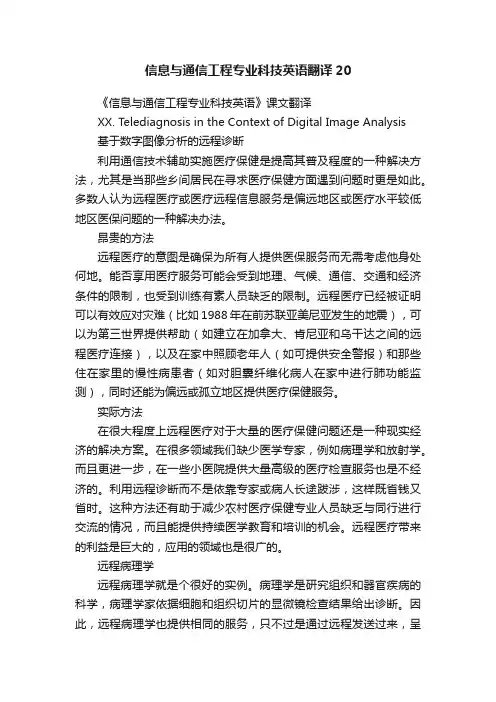
信息与通信工程专业科技英语翻译20《信息与通信工程专业科技英语》课文翻译XX. Telediagnosis in the Context of Digital Image Analysis基于数字图像分析的远程诊断利用通信技术辅助实施医疗保健是提高其普及程度的一种解决方法,尤其是当那些乡间居民在寻求医疗保健方面遇到问题时更是如此。
多数人认为远程医疗或医疗远程信息服务是偏远地区或医疗水平较低地区医保问题的一种解决办法。
昂贵的方法远程医疗的意图是确保为所有人提供医保服务而无需考虑他身处何地。
能否享用医疗服务可能会受到地理、气候、通信、交通和经济条件的限制,也受到训练有素人员缺乏的限制。
远程医疗已经被证明可以有效应对灾难(比如1988年在前苏联亚美尼亚发生的地震),可以为第三世界提供帮助(如建立在加拿大、肯尼亚和乌干达之间的远程医疗连接),以及在家中照顾老年人(如可提供安全警报)和那些住在家里的慢性病患者(如对胆囊纤维化病人在家中进行肺功能监测),同时还能为偏远或孤立地区提供医疗保健服务。
实际方法在很大程度上远程医疗对于大量的医疗保健问题还是一种现实经济的解决方案。
在很多领域我们缺少医学专家,例如病理学和放射学。
而且更进一步,在一些小医院提供大量高级的医疗检查服务也是不经济的。
利用远程诊断而不是依靠专家或病人长途跋涉,这样既省钱又省时。
这种方法还有助于减少农村医疗保健专业人员缺乏与同行进行交流的情况,而且能提供持续医学教育和培训的机会。
远程医疗带来的利益是巨大的,应用的领域也是很广的。
远程病理学远程病理学就是个很好的实例。
病理学是研究组织和器官疾病的科学,病理学家依据细胞和组织切片的显微镜检查结果给出诊断。
因此,远程病理学也提供相同的服务,只不过是通过远程发送过来,呈现在屏幕上的组织样本的显微镜图像来进行分析。
只有最大的医院才提供病理服务。
小医院和诊所通常会将手术活体切片和细胞样本送到这些医院或者是商用的实验室去检查和诊断。
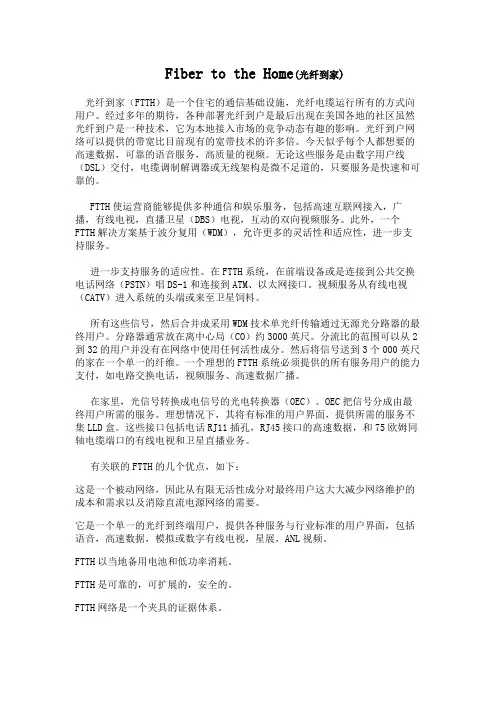
Fiber to the Home(光纤到家)光纤到家(FTTH)是一个住宅的通信基础设施,光纤电缆运行所有的方式向用户。
经过多年的期待,各种部署光纤到户是最后出现在美国各地的社区虽然光纤到户是一种技术,它为本地接入市场的竞争动态有趣的影响。
光纤到户网络可以提供的带宽比目前现有的宽带技术的许多倍。
今天似乎每个人都想要的高速数据,可靠的语音服务,高质量的视频。
无论这些服务是由数字用户线(DSL)交付,电缆调制解调器或无线架构是微不足道的,只要服务是快速和可靠的。
FTTH使运营商能够提供多种通信和娱乐服务,包括高速互联网接入,广播,有线电视,直播卫星(DBS)电视,互动的双向视频服务。
此外,一个FTTH解决方案基于波分复用(WDM),允许更多的灵活性和适应性,进一步支持服务。
进一步支持服务的适应性。
在FTTH系统,在前端设备或是连接到公共交换电话网络(PSTN)唱DS-1和连接到ATM、以太网接口。
视频服务从有线电视(CATV)进入系统的头端或来至卫星饲料。
所有这些信号,然后合并成采用WDM技术单光纤传输通过无源光分路器的最终用户。
分路器通常放在离中心局(CO)约3000英尺。
分流比的范围可以从2到32的用户并没有在网络中使用任何活性成分。
然后将信号送到3个000英尺的家在一个单一的纤维。
一个理想的FTTH系统必须提供的所有服务用户的能力支付,如电路交换电话,视频服务、高速数据广播。
在家里,光信号转换成电信号的光电转换器(OEC)。
OEC把信号分成由最终用户所需的服务。
理想情况下,其将有标准的用户界面,提供所需的服务不集LLD盒。
这些接口包括电话RJ11插孔,RJ45接口的高速数据,和75欧姆同轴电缆端口的有线电视和卫星直播业务。
有关联的FTTH的几个优点,如下:这是一个被动网络,因此从有限无活性成分对最终用户这大大减少网络维护的成本和需求以及消除直流电源网络的需要。
它是一个单一的光纤到终端用户,提供各种服务与行业标准的用户界面,包括语音,高速数据,模拟或数字有线电视,星展,ANL视频。
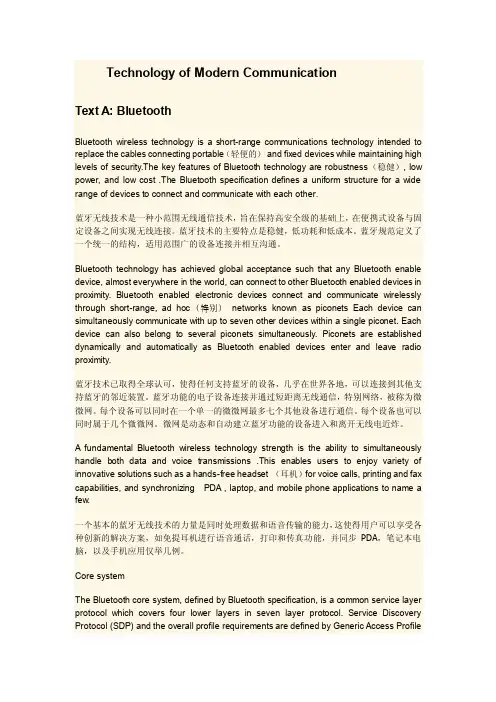
Technology of Modern CommunicationText A: BluetoothBluetooth wireless technology is a short-range communications technology intended to replace the cables connecting portable(轻便的)and fixed devices while maintaining high levels of security.The key features of Bluetooth technology are robustness(稳健), low power, and low cost .The Bluetooth specification defines a uniform structure for a wide range of devices to connect and communicate with each other.蓝牙无线技术是一种小范围无线通信技术,旨在保持高安全级的基础上,在便携式设备与固定设备之间实现无线连接。
蓝牙技术的主要特点是稳健,低功耗和低成本。
蓝牙规范定义了一个统一的结构,适用范围广的设备连接并相互沟通。
Bluetooth technology has achieved global acceptance such that any Bluetooth enable device, almost everywhere in the world, can connect to other Bluetooth enabled devices in proximity. Bluetooth enabled electronic devices connect and communicate wirelessly through short-range, ad hoc(特别)networks known as piconets Each device can simultaneously communicate with up to seven other devices within a single piconet. Each device can also belong to several piconets simultaneously. Piconets are established dynamically and automatically as Bluetooth enabled devices enter and leave radio proximity.蓝牙技术已取得全球认可,使得任何支持蓝牙的设备,几乎在世界各地,可以连接到其他支持蓝牙的邻近装置。
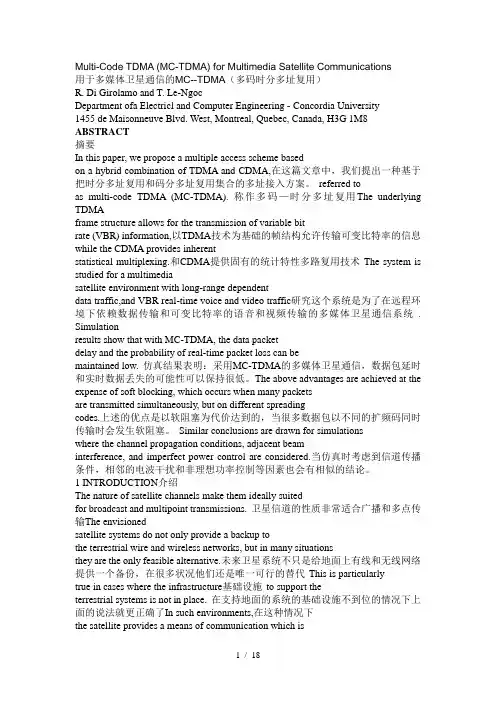
Multi-Code TDMA (MC-TDMA) for Multimedia Satellite Communications用于多媒体卫星通信的MC--TDMA(多码时分多址复用)R. Di Girolamo and T. Le-NgocDepartment ofa Electricl and Computer Engineering - Concordia University1455 de Maisonneuve Blvd. West, Montreal, Quebec, Canada, H3G 1M8 ABSTRACT摘要In this paper, we propose a multiple access scheme basedon a hybrid combination of TDMA and CDMA,在这篇文章中,我们提出一种基于把时分多址复用和码分多址复用集合的多址接入方案。
referred toas multi-code TDMA (MC-TDMA). 称作多码—时分多址复用The underlying TDMAframe structure allows for the transmission of variable bitrate (VBR) information,以TDMA技术为基础的帧结构允许传输可变比特率的信息while the CDMA provides inherentstatistical multiplexing.和CDMA提供固有的统计特性多路复用技术The system is studied for a multimediasatellite environment with long-range dependentdata traffic,and VBR real-time voice and video traffic研究这个系统是为了在远程环境下依赖数据传输和可变比特率的语音和视频传输的多媒体卫星通信系统 . Simulationresults show that with MC-TDMA, the data packetdelay and the probability of real-time packet loss can bemaintained low. 仿真结果表明:采用MC-TDMA的多媒体卫星通信,数据包延时和实时数据丢失的可能性可以保持很低。
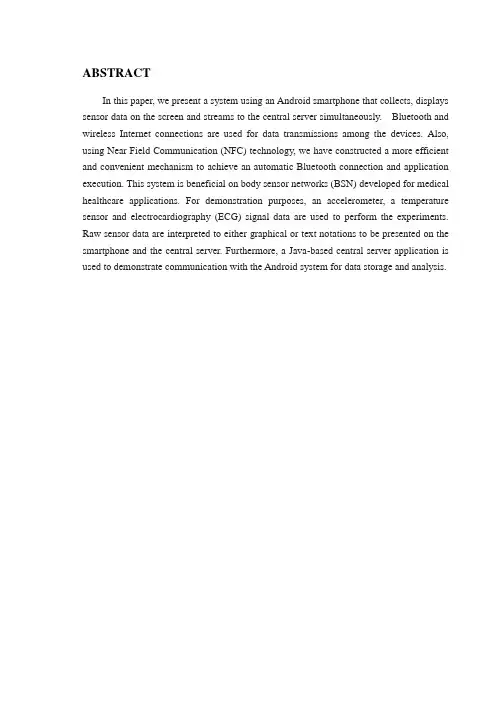
ABSTRACTIn this paper, we present a system using an Android smartphone that collects, displays sensor data on the screen and streams to the central server simultaneously. Bluetooth and wireless Internet connections are used for data transmissions among the devices. Also, using Near Field Communication (NFC) technology, we have constructed a more efficient and convenient mechanism to achieve an automatic Bluetooth connection and application execution. This system is beneficial on body sensor networks (BSN) developed for medical healthcare applications. For demonstration purposes, an accelerometer, a temperature sensor and electrocardiography (ECG) signal data are used to perform the experiments. Raw sensor data are interpreted to either graphical or text notations to be presented on the smartphone and the central server. Furthermore, a Java-based central server application is used to demonstrate communication with the Android system for data storage and analysis.1INTRODUCTIONMobile communication devices are designed to achieve multiple purposes but mostly are focused on voice and short messaging services. Wireless technology has the benefit of improving data mobility, using different protocols such as Wi- Fi and Bluetooth. In the medical field, many studies introduced body sensor networks (BSN) for healthcare applications. BSN improves the patient’s monitoring system with the help of the modern technology. This can be done by various wearable sensors equipped with wireless capabilities, In addition, as seen in various researches, it is desirable to develop a low power system. Different types of sensors can be used for monitoring movements, temperature changes, heart-beat, blood pressure and more to establish a patient monitoring system. Bluetooth is one of the widely available options for managing wireless networks to simultaneously connect up to 7 ancillary devices.In this paper, we introduce a microcontroller system that communicates via Bluetooth with the smartphone for data collections, and streams data simultaneously to the central server for data storage and analysis via the Internet. This system provides a solution for mobile patients by forming a wireless BSN in Bluetooth and Wi-Fi/cellular Internet connections with a common Android smartphone which can monitor the patient status via wireless data transmission.2SYSTEM DESIGNFigure 1 represents the Mobile Sensor Data Collector that involves Bluetooth, Near Field Communication (NFC) and wireless Internet connections for collecting, streaming, storing and analyzing sensor data in real-time. Three different sensors transfer sampled data to the MSP430BT5190 which communicate with the CC2560 Bluetooth transmitter via UART and sends data to a smartphone using the Android and Bluetooth system. On the phone, it displays received data on the screen and streams to the server for storage and data analysis. The term “real-time” in this paper is used to express that data transfers are achieved without perceivable delays among the devices. Also, since the Android system is capable of running application software in the background mode, the application used in this paper has the ability to transfer data during a phone call.Figure 1Overall Design of Mobile Sensor Data CollectorA Java-based UDP server application is used to collect data sent from the smartphone via the Internet. When receiving data from the smartphone, the server application displays and saves all received data to a text file for later analysis. For experimental purposes, this server was implemented with an ordinary desktop to demonstrate our fundamental idea. Also, UDP protocol was chosen over TCP because UDP usually achieves faster transmission than the TCP protocol by not waiting for an acknowledgment signal back to the origin.3EXPERIMENT RESULTSAs shown in Figure 1, all experiments are initiated using an NFC tagging process to start the Android application and initiate the Bluetooth connection automatically. In this particular smartphone, the NFC tag reader is located on the backside. The user needs to tap on the NFC tag as shown in Figure 2 to run the program. The NFC tag containing theBluetooth MAC address of the CC2560 Bluetooth device is attached to demonstrate where the tag should be located.Figure 2Initiating connection processUp to 7 ancillary sensor nodes can be simultaneously connected to the Android system. However, a single sensor Bluetooth connection was employed for testing purposes.3.1Accelerometer Data CollectionIn this paper, the Android 2.3.3 and 4.0.3 operating systems are tested using Google Nexus S to display collected data and stream data to the server. The design of the new system is achieved first by collecting sensor data from the MSP430BT5190, transferred via the CC2560 Bluetooth transmitter. Then, the Bluetooth transmitter sends data to the smartphone, which displays the collected data in real-time. As an example, Figure 3(a) shows the accelerometer data collected and displayed on the smartphone in text and Figure 3(b) shows the data in the graphical notation.Figure 3Received real-time acceleration data display(a) text notation;(b) graphical notationThese data are being sent to the central server either via Wi-Fi or cellular networks for storage and analysis at the same time. Figure 4 shows the received data from the smartphone displayed on the server. The server also saves data to a text file in the designated directory for data analysis.Figure 4Received real-time acceleration data on server An axis value representation depends on the raw sensor data and this raw data could differ from the sensors. There are 3 axes provided from the sensor and each set of data needs to be interpreted. For this particular device used in this paper, x- axis data between -60 and -50 represents LEFT, between +50 and +60 represents RIGHT. This rule applies similarly to the other two axes. This differs from other sensors where the data output of acceleration is normally represented in terms of m/s2. However, a translation algorithm shares the same idea. Figure 5 is the result of translating the accelerometer data based on accelerometer movements.Figure5Accelerometer data translationThis type of the accelerometer translation was extended to the Snake Game sample provided by Android Developers [9]. The original game uses touch screen inputs to control the snake. The touch screen inputs were replaced by accelerometer movements to provide data in LEFT, RIGHT, UP and DOWN. The data analysis was done on the phone itself for test purposes. Figure 6 shows the movement of the snake on the phone that is controlled by accelerometer data from the MSP430 eZ430-RF2560.Figure 6Remote controlling Snake GameThis example emphasizes that accelerometer data can be adapted for the patientmovement detection system. Multiple accelerometers could be implemented to produce more advanced movement analysis.3.2Temperature Sensor Data CollectionA temperature sensor monitoring the real-time room temperature is used to perform the experiment. The procedure of the experiment resembles the previous section but with the different data interpretation. In this particular experiment, a heat gun was used to heat up or cool down the sensor for testing purposes as shown in Figure 7. Similar to the previous accelerometer application, Figure 8(a) shows the text notation of the received data in real-time and Figure 8(b) shows the graphical notation of the received data in real-time. Particularly in the graphical notation output, we provide a warning message if the temperature exceeds more than 35 degrees Celsius. Also, the graphical notation has a range of between 0 degrees Celsius to 50 degrees Celsius for this demonstration.Figure 9 shows the server displaying the received data from the smartphone. It delivers similar outputs compared to the accelerometer demonstration and also saves it to a text file.Figure 7Testing temperature sensor data transmissionFigure 8Received real-time temperature data display(a) text notation;(b) graphical notationFigure 9Received real-time temperature data on server3.3Electrocardiography (ECG) Data CollectionThe ECG signal is an important part of a patient monitoring system. Currently, ECG machines are dependent on wired connections which limit their data mobility. Our system using the Bluetooth protocol for ECG signal collections greatly enhances the mobility. This ECG signal is also sent simultaneously to the server via a wireless Internet connection through the smartphone in real-time. Figure 10 shows the display of received ECG signal on the smartphone and Figure 11 shows the same result transmitted to the server in the text format.Figure 10Received real-time ECG data in graphical notationFigure 11Received real-time ECG data on serverHeart-beat rate (BPM) can be determined after analysis of the data either on the smartphone or the server. In this particular example, it represents a patient’s stablecondition with a normal heart-beat rate at approximately 72 BPM. This type of data can be diagnostically valuable and easily transmitted for consultations with distant experts.3.4Overall Data Transmission Rate (DTR)The Data Transmission Rate (DTR) is another important part of the system considering the data size. In our system, DTR depends on the microcontroller, the Bluetooth transmitter and the wireless Internet connection speed. An UART connection between the sensor and microcontroller is established at the baud rate of 115200 bps which achieves a communication bandwidth up to 15KB/s. This emphasizes that our system is capable of the data transmission by integrating multiple types of sensors for a body sensor network system that can be important for patient monitoring, real-time data analysis and diagnosis.4CONCLUSIONSIn this paper, we introduced a system using the smartphone for collecting real-time sensor data and simultaneously streaming the data to the server using Bluetooth and Internet connections. This design is the advancement over ordinary wired sensor networks which are restricted to a fixed monitoring location. In the proposed system, an accelerometer, a temperature sensor and ECG signals have been selected for data transmission using Bluetooth and wireless Internet connections. Having the Bluetooth transmitter on the smartphone, the Android system receives and displays the data on the screen in the graphical or text format and streams the collected data to the central server for data analysis, diagnosis and archiving. Taking advantage of the Android system, NFC technology was used to reduce the unnecessary Bluetooth connection process. This system is highly scalable to include more sensors to produce an upgraded patient monitoring system that is both more accurate and responsive. Furthermore, storing history of collected sensor data in the central server is extremely critical for reliable patient diagnosis.摘要在本文中,我们提出了一个使用Android智能手机,收集传感器数据显示在屏幕上并同步到中央服务器的数据流同步系统。

X. Third Generation Wireless Networks第三代无线网络移动通信简介电信工业面临着向用户稀少而安装固定电话网络成本很高的乡间地区提供电话服务的问题。
降低有线电话高昂基础设施费用的一个方法是使用固定无线电网络。
这一方面存在的问题是,对于乡间和城市需要由大的蜂窝单元以达到足够的覆盖。
而且由于多径传播的长时间延迟又遇到额外的问题。
目前在澳大利亚全球移动通信系统(GSM)技术正被用于农村地区的固定无线电话系统。
然而GSM使用时分复用(TDMA),这种技术的符号速率很高,会导致多径引起码间干扰的问题。
人们正在考虑用于下一代数字电话系统的好几种技术,目的是改进蜂窝单元的容量、抗多径干扰以及灵活性。
这些技术包括CDMA和COFDM,这两者都能用于向农村提供固定无线系统。
不过每一种技术有不同的性质,分别适用于特定的应用。
COFDM目前正用于一些新的无线广播系统包括高清晰度电视(HDTV)提案和数字音频广播(DAB),而对COFDM作为一种移动通信系统的传输方法却研究甚少。
在CDMA中所有用户在同一频带中传输,他们用特殊的码实现信道化。
基站和移动站都知道用于调制发送数据的码。
OFDM/COFDM通过将可用带宽分成许多窄带载波使许多用户能在给定的频带内发送信号。
每个用户分配到若干载波在其中发送数据。
传输以这样的方法进行:载波之间相互正交因而它们可以被安排得比标准得频分复用(FDM)拥挤得多,这就使OFDM/COFDM有很高的频谱使用效率。
第三代无线网络数字网络使用的扩展已经导致了设计大容量通信网络的需要。
在欧洲,蜂窝型系统到2000年的需求预计将达到1500至2000万户,而美国(1995年)已经超过了3000万户。
无线通信服务正以每年50%的速度增长,目前的第二代欧洲数字系统(GSM)预期在21世纪初达到饱和。
随着广泛的业务需求如视频会议、互联网服务、数据网络、多媒体等的发展,电信工业也在变化之中。
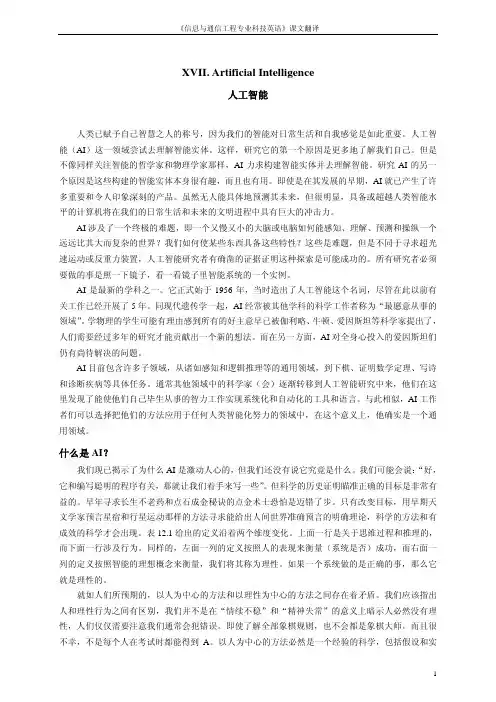
XVII. Artificial Intelligence人工智能人类已赋予自己智慧之人的称号,因为我们的智能对日常生活和自我感觉是如此重要。
人工智能(AI)这一领域尝试去理解智能实体。
这样,研究它的第一个原因是更多地了解我们自己。
但是不像同样关注智能的哲学家和物理学家那样,AI力求构建智能实体并去理解智能。
研究AI的另一个原因是这些构建的智能实体本身很有趣,而且也有用。
即使是在其发展的早期,AI就已产生了许多重要和令人印象深刻的产品。
虽然无人能具体地预测其未来,但很明显,具备或超越人类智能水平的计算机将在我们的日常生活和未来的文明进程中具有巨大的冲击力。
AI涉及了一个终极的难题,即一个又慢又小的大脑或电脑如何能感知、理解、预测和操纵一个远远比其大而复杂的世界?我们如何使某些东西具备这些特性?这些是难题,但是不同于寻求超光速运动或反重力装置,人工智能研究者有确凿的证据证明这种探索是可能成功的。
所有研究者必须要做的事是照一下镜子,看一看镜子里智能系统的一个实例。
AI是最新的学科之一。
它正式始于1956年,当时造出了人工智能这个名词,尽管在此以前有关工作已经开展了5年。
同现代遗传学一起,AI经常被其他学科的科学工作者称为“最愿意从事的领域”。
学物理的学生可能有理由感到所有的好主意早已被伽利略、牛顿、爱因斯坦等科学家提出了,人们需要经过多年的研究才能贡献出一个新的想法。
而在另一方面,AI对全身心投入的爱因斯坦们仍有尚待解决的问题。
AI目前包含许多子领域,从诸如感知和逻辑推理等的通用领域,到下棋、证明数学定理、写诗和诊断疾病等具体任务。
通常其他领域中的科学家(会)逐渐转移到人工智能研究中来,他们在这里发现了能使他们自己毕生从事的智力工作实现系统化和自动化的工具和语言。
与此相似,AI工作者们可以选择把他们的方法应用于任何人类智能化努力的领域中,在这个意义上,他确实是一个通用领域。
什么是AI?我们现已揭示了为什么AI是激动人心的,但我们还没有说它究竟是什么。
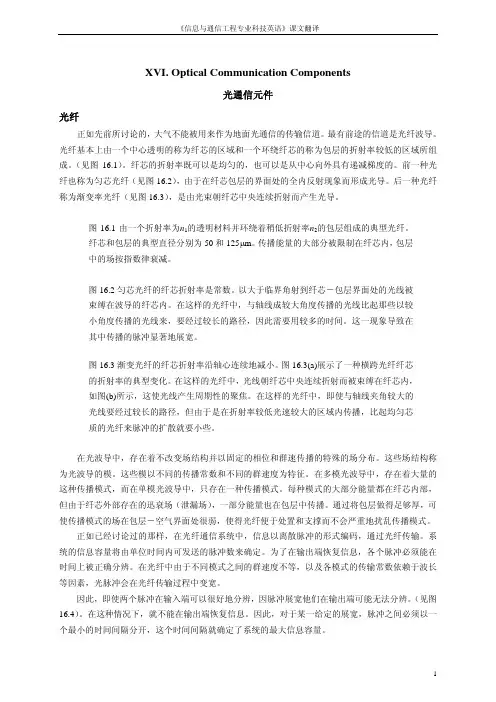
XVI. Optical Communication Components光通信元件光纤正如先前所讨论的,大气不能被用来作为地面光通信的传输信道。
最有前途的信道是光纤波导。
光纤基本上由一个中心透明的称为纤芯的区域和一个环绕纤芯的称为包层的折射率较低的区域所组成。
(见图16.1)。
纤芯的折射率既可以是均匀的,也可以是从中心向外具有递减梯度的。
前一种光纤也称为匀芯光纤(见图16.2),由于在纤芯包层的界面处的全内反射现象而形成光导。
后一种光纤称为渐变率光纤(见图16.3),是由光束朝纤芯中央连续折射而产生光导。
图16.1由一个折射率为n1的透明材料并环绕着稍低折射率n2的包层组成的典型光纤。
纤芯和包层的典型直径分别为50和125μm。
传播能量的大部分被限制在纤芯内,包层中的场按指数律衰减。
图16.2匀芯光纤的纤芯折射率是常数。
以大于临界角射到纤芯-包层界面处的光线被束缚在波导的纤芯内。
在这样的光纤中,与轴线成较大角度传播的光线比起那些以较小角度传播的光线来,要经过较长的路径,因此需要用较多的时间。
这一现象导致在其中传播的脉冲显著地展宽。
图16.3渐变光纤的纤芯折射率沿轴心连续地减小。
图16.3(a)展示了一种横跨光纤纤芯的折射率的典型变化。
在这样的光纤中,光线朝纤芯中央连续折射而被束缚在纤芯内,如图(b)所示,这使光线产生周期性的聚焦。
在这样的光纤中,即使与轴线夹角较大的光线要经过较长的路径,但由于是在折射率较低光速较大的区域内传播,比起均匀芯质的光纤来脉冲的扩散就要小些。
在光波导中,存在着不改变场结构并以固定的相位和群速传播的特殊的场分布。
这些场结构称为光波导的模。
这些模以不同的传播常数和不同的群速度为特征。
在多模光波导中,存在着大量的这种传播模式,而在单模光波导中,只存在一种传播模式。
每种模式的大部分能量都在纤芯内部,但由于纤芯外部存在的迅衰场(泄漏场),一部分能量也在包层中传播。
通过将包层做得足够厚,可使传播模式的场在包层-空气界面处很弱,使得光纤便于处置和支撑而不会严重地扰乱传播模式。
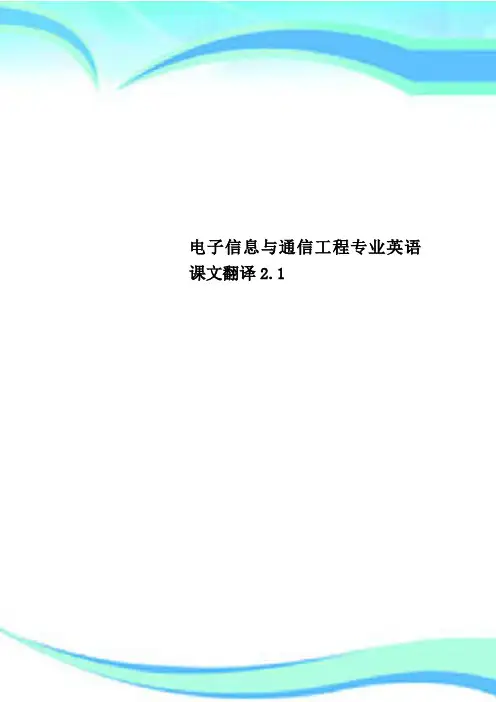
电子信息与通信工程专业英语课文翻译2.1————————————————————————————————作者:————————————————————————————————日期:2电路系统与设计2.1电路和系统1.基础概念电荷和导电性在Bohr的原子理论中(以Niels Bohr命名,1885-1962),电子围绕着质子和种子运动。
在相反极性电子和质子的电荷之间的吸引力使得原子连在一起。
具有同种电荷的粒子将会相互排斥。
电荷的测量值是库伦。
一个单独的电子或质子的电荷远小于一库伦,一个电子是—1.6×1(-19)库伦,一个质子是1.6×10(-19)库伦。
自然表明,只有一个质子的电荷和电子是反极性的。
这里没有固有的负极电子,只是很容易被称为正极的和质子负极的。
原子不同形态的电子有不同程度的自由度。
一些材料的形态,例如金属,最外层的电子受到很弱的约束使得它们能够在室温热能量的影响下载原子空间中自由运动。
因为这些事实上不受约束的电子式可以在自身的原子中自由运动的,也可以漂浮在临近的原子周围的空间中,它们常被称为自由电子。
在其他一些形态的材料中如玻璃,它的原子的电子几乎不能自由移动。
当外部的力量如物理摩擦时,能够强迫一些电子离开它们自身的原子,移动到其他物质的原子中,它们在材料的原子中不能很容易的移动。
这些在材料中电子的移动性的关系被认为是电子的导电性。
导电性决定于材料中原子的形态(每个原子核的栀子数,决定他的化学特性。
)和原子是怎样与另一个原子连接在一起的。
有高度灵活电子的材料(许多自由电子)被称为导体,而有很少灵活电子的材料(几乎或是没有自由电子)的材料被称为绝缘体。
必须知道,一些物质的化学特性将在不同环境下改变。
例如,玻璃在室温下是一个非常好的绝缘体,但当把它加热到相当高的温度时它就变成一个导体。
气体如空气,常态下是绝缘体,但如果加热到很高的温度也会变成导体。
大部分金属被加热时导电性能会下降,而被冷制的时候导电性能会更好。

IX. Multiple Access Techniques: FDMA, TDMA and CDMA复用技术:频分复用、时分复用、码分复用复用方案用于使许多用户同时使用同一个固定的无线电频带。
在任何无线电系统中分配的带宽总是有限的。
移动无线电话系统的典型总带宽是50MHz,它被分成两半用以提供系统的前向和反向连接。
任何无线网络为了提高用户容量都需要共享频谱。
频分复用(FDMA)、时分复用(TDMA)、码分复用(CDMA)是无线系统中由众多用户共享可用带宽的三种主要方法。
这些方法又有许多扩展和混合技术,例如正交频分复用(OFDM),以及混合时分和频分复用系统。
不过要了解任何扩展技术首先要求对三种基本方法的理解。
频分复用在FDMA中,可用带宽被分为多个较窄的频带。
每一用户被分配一个独特的频带用于发送和接收。
在一次通话中其他用户不能使用同一频带。
每个用户分配到一个由基站到移动电话的前向信道以及一个返回基站的反向信道,每个信道都是一个单向连接。
在每个信道中发送信号是连续的,以便进行模拟通信。
FDMA信道的带宽一般较小(30kHz),每个信道只支持一个用户。
FDMA作为大多数多信道系统的一部分用于初步分割分配到的宽频带。
将可用带宽分配给几个信道的情况见图9.1和图9.2。
时分复用通过分配给每一个用户一个时隙以便在其中发送或接收,TDMA将可用频谱分成多个时隙。
图9.3显示如何以一种循环复用的方式把时隙分配给用户,每个用户每帧分得一个时隙。
TDMA以缓冲和爆发方式发送数据。
因此每个信道的发射是不连续的。
待发送的输入数据在前一帧期间被缓存,在分配给该信道的时隙中以较高速率爆发式发送出去。
TDMA不能直接传送模拟信号因为它需要使用缓冲,因而只能用于传输数字形式的数据。
由于通常发射频率很高,TDMA会受到多径效应的影响。
这导致多径信号引起码间干扰。
TDMA一般与FDMA结合使用,将可用的全部带宽划分为若干信道。
1864年,JCM 提出了一个在科学历史上最为成功的理论。
在皇家协会一个出名的研究报告中,他描述了9个方程式,总结了所有已知的电学和磁学定律。
总结了所有已知的电学和磁学定律。
这不仅仅是将其罗列出这不仅仅是将其罗列出来。
假设的提出是需要附加条件使得方程式的前后一致。
而Maxwell 提出的一个完整的场理论,理论,我们需要一个源场,一个介质场,我们需要一个源场,一个介质场,我们需要一个源场,一个介质场,和一系列场微分方程。
这些都允许我们用数学的方和一系列场微分方程。
这些都允许我们用数学的方式去描述有关于影响(介质场)和诱因(源场)之间的关系。
一个好的假设的提出,需要包括设定的构成关系和有关于一些场括设定的构成关系和有关于一些场 的边界表面积和初使时间的关系。
一个电磁场如果要有物理意义,物理意义,我们必需将其与一些可观测的量联系起来,比如力场。
我们必需将其与一些可观测的量联系起来,比如力场。
我们必需将其与一些可观测的量联系起来,比如力场。
最后,最后,最后,允许用来解决涉及允许用来解决涉及数学上的不连续点的问题,必须规定一个确定的范围或一个跳变的情况条件。
数学上的不连续点的问题,必须规定一个确定的范围或一个跳变的情况条件。
在Maxwell 的方程中,源场包含矢量场的方程中,源场包含矢量场 J (r,t )(电流密度)和标量场P (电荷密度)。
介质场 就是组成电磁场的四个矢量场就是组成电磁场的四个矢量场 电流密度(矢量)电流密度(矢量)电荷密度(标量)电荷密度(标量)电场强度(矢量)电场强度(矢量)电通量密度(矢量)电通量密度(矢量)磁通量密度(标量)磁通量密度(标量)磁场强度(标量)磁场强度(标量)以上这些量,在一个时变场中,是任意真正作用空间,如下,方向矢量r 和时间,在静态场时任是r 的功能。
的功能。
两个新的概念得先确立下:两个新的概念得先确立下:变化的电场会产生磁场,变化的电场会产生磁场,变化的电场会产生磁场,变化的磁场出会产生电场,变化的磁场出会产生电场,变化的磁场出会产生电场,所以我们称所以我们称其为电磁场。
Unit 13Comparison between GSM and CDMA GSM与CDMA之比较Using CDMA/FDD technology, subscribers of CDMA cellular mobile communication system can transmit their information simultaneously through the same channel. On the other hand, the GSM system adopts TDMA/FDD method to transmit and distinguish information from different GSM mobile stations. In addition, in favor of QCELP arithmetic, RAKE receiver, power control and soft switching etc., CDMA shows more advantages in its system performance than the GSM, such as greater anti-interference capability, bigger system capacity, higher successful connection ratio, fewer off-line chances, low probability of intercept(LPI), and so on.使用码分多址/频分双工技术,用户的蜂窝移动通信系统的传输信息的同时,通过同样的渠道。
另一方面,该系统采用时分多址/频分双工传输的方法和识别信息从不同的移动台。
此外,有利于中国电信集团广州研发中心算术,耙式接收器,功率控制和软开关等,显示出更多的优势在码分多址系统性能比,如更高的抗干扰能力,更大的系统容量,连接成功率较高,离线的机会少,低截获概率(低截获概率),等。
ResistorA resistor is a two-terminal electronic component that opposes an electric current by producing a voltage drop between its terminals in proportion to the current, that is ,in accordance wit h Ohm’s law :V=IR .The electrica l resistance R is equal to the voltage drop V across the resistor divided by the current I through the resistor. Resistors are used as part of electrical networks and electronic circuits.电阻器是一个二端口电子元件,电阻是阻止电流流动,通过按比例产生其端子之间的电压降的电流,也就是说,根据欧姆定律:V = IR。
电阻R等于电压降V除以通过电阻的电流I。
电阻作为电子网络和电子电路的一部分。
TransistorIn electronics, a transistor is a semiconductor device commonly used to amplify or switch electronic signals . A transistor is made of a solid piece of a semiconductor material , with at least three terminals for connection to an external circuit. A voltage or current applied to one pair of the transistor’s terminals changes the current flowing through another pair of terminals. Because the controlled current can be much larger than the controlling current, the transistor provides amplification of a signal. The transistor is the fundamental building block of modern electronic devices, and is used in radio, telephone, computer and other electronic systems. Some transistors are packaged individually but most are found in integrated circuits.在电子技术中,晶体管是一种,常用来放大或进行开关控制电子信号的半导体器。
电子信息与通信工程专业英语课文翻译2.1————————————————————————————————作者:————————————————————————————————日期:2电路系统与设计2.1电路和系统1.基础概念电荷和导电性在Bohr的原子理论中(以Niels Bohr命名,1885-1962),电子围绕着质子和种子运动。
在相反极性电子和质子的电荷之间的吸引力使得原子连在一起。
具有同种电荷的粒子将会相互排斥。
电荷的测量值是库伦。
一个单独的电子或质子的电荷远小于一库伦,一个电子是—1.6×1(-19)库伦,一个质子是1.6×10(-19)库伦。
自然表明,只有一个质子的电荷和电子是反极性的。
这里没有固有的负极电子,只是很容易被称为正极的和质子负极的。
原子不同形态的电子有不同程度的自由度。
一些材料的形态,例如金属,最外层的电子受到很弱的约束使得它们能够在室温热能量的影响下载原子空间中自由运动。
因为这些事实上不受约束的电子式可以在自身的原子中自由运动的,也可以漂浮在临近的原子周围的空间中,它们常被称为自由电子。
在其他一些形态的材料中如玻璃,它的原子的电子几乎不能自由移动。
当外部的力量如物理摩擦时,能够强迫一些电子离开它们自身的原子,移动到其他物质的原子中,它们在材料的原子中不能很容易的移动。
这些在材料中电子的移动性的关系被认为是电子的导电性。
导电性决定于材料中原子的形态(每个原子核的栀子数,决定他的化学特性。
)和原子是怎样与另一个原子连接在一起的。
有高度灵活电子的材料(许多自由电子)被称为导体,而有很少灵活电子的材料(几乎或是没有自由电子)的材料被称为绝缘体。
必须知道,一些物质的化学特性将在不同环境下改变。
例如,玻璃在室温下是一个非常好的绝缘体,但当把它加热到相当高的温度时它就变成一个导体。
气体如空气,常态下是绝缘体,但如果加热到很高的温度也会变成导体。
大部分金属被加热时导电性能会下降,而被冷制的时候导电性能会更好。
3.2 数字信号处理1 简介数字信号处理是21世纪用于科学和工程领域最强大的技术之一,它使一个广阔的领域发生了革命性的改变:通信,医学影像,雷达或声纳,高保真音乐复制,石油勘测,以上只是列举几个。
每个领域都有它自身独特的算法(algorithm),数学运算(mathematic),专用工艺(specialized technique)。
数字信号处理在计算机科学方面有别于其他领域,因为他采用一种特殊的数据类型:信号。
现代社会中,我们的身边充满各种类型的信号。
有些信号是天然形成的,但大多数是人为制造的。
有些信号是必要的(语音),有些是宜人的(音乐),而有些信号在某个特定的场合是不需要或不必要的。
在大多数情况下,这些信号来源于人对真实世界的感觉,比如地震的震动,视觉图像,声音波形等。
数字信号处理是一种数学工具,是一种用来处理那些将上述信号转换成数字形式后的信号的算法和技术。
这包括一系列目的,如:视觉图像的优化处理,语音识别和生成,数据压缩存储和传输等。
在工程范围内,信号是信息的载体,既有益又有害。
信号处理中最简单的形式是从一连串相互矛盾的信息中提取和增强有用信息。
信息的有用和无用往往只是主管和客观的区别。
因此信号处理往往依赖于应用程序。
傅里叶分析和滤波器设计是信号处理时常用的方法。
他们的原则简单描述如下。
2 傅里叶分析函数的傅里叶表示,即将函数表示成正弦和余弦信号的叠加,这种方法已经广泛用于微分方程的解析法和数值法求解过程以及通信信号的分析和处理。
傅里叶变换的效用在于它能够在时域范围内分析它的频率内容。
变换的第一步是将时域上的函数转换为时域表示。
(The transform works by first translating a function in the time domain into a function in the frequency domain)。
然后就可以分析信号的频率内容了。
因为变换函数的傅里叶系数代表各个正弦和余弦函数在各自对应频率区间的分配。
ResistorA resistor is a two-terminal electronic component that opposes an electric current by producing a voltage drop between its terminals in proportion to the current, that is,in accordance with Ohm’s law :V=IR .The electrical resistance R is equal to the voltage drop V across the resistor divided by the current I through the resistor. Resistors are used as part of electrical networks and electronic circuits.电阻器是一个二端口电子元件,电阻是阻止电流流动,通过按比例产生其端子之间的电压降的电流,也就是说,根据欧姆定律:V = IR。
电阻R等于电压降V除以通过电阻的电流I。
电阻作为电子网络和电子电路的一部分。
TransistorIn electronics, a transistor is a semiconductor device commonly used to amplify or switch electronic signals .A transistor is made of a solid piece of a semiconductor material , with at least three terminals for connection to an external circuit. A voltage or current applied to one pair of the transistor’s terminals changes the current flowing through another pair of terminals. Because the controlled current can be much larger than the controlling current, the transistor provides amplification of a signal. The transistor is the fundamental building block of modern electronic devices, and is used in radio, telephone, computer and other electronic systems. Some transistors are packaged individually but most are found in integrated circuits.在电子技术中,晶体管是一种,常用来放大或进行开关控制电子信号的半导体器。
Technology of Modern CommunicationText A: BluetoothBluetooth wireless technology is a short-range communications technology intended to replace the cables connecting portable(轻便的)and fixed devices while maintaining high levels of security.The key features of Bluetooth technology are robustness(稳健), low power, and low cost .The Bluetooth specification defines a uniform structure for a wide range of devices to connect and communicate with each other.蓝牙无线技术是一种小范围无线通信技术,旨在保持高安全级的基础上,在便携式设备与固定设备之间实现无线连接。
蓝牙技术的主要特点是稳健,低功耗和低成本。
蓝牙规范定义了一个统一的结构,适用范围广的设备连接并相互沟通。
Bluetooth technology has achieved global acceptance such that any Bluetooth enable device, almost everywhere in the world, can connect to other Bluetooth enabled devices in proximity. Bluetooth enabled electronic devices connect and communicate wirelessly through short-range, ad hoc(特别)networks known as piconets Each device can simultaneously communicate with up to seven other devices within a single piconet. Each device can also belong to several piconets simultaneously. Piconets are established dynamically and automatically as Bluetooth enabled devices enter and leave radio proximity.蓝牙技术已取得全球认可,使得任何支持蓝牙的设备,几乎在世界各地,可以连接到其他支持蓝牙的邻近装置。
蓝牙功能的电子设备连接并通过短距离无线通信,特别网络,被称为微微网。
每个设备可以同时在一个单一的微微网最多七个其他设备进行通信。
每个设备也可以同时属于几个微微网。
微网是动态和自动建立蓝牙功能的设备进入和离开无线电近炸。
A fundamental Bluetooth wireless technology strength is the ability to simultaneously handle both data and voice transmissions .This enables users to enjoy variety of innovative solutions such as a hands-free headset (耳机)for voice calls, printing and fax capabilities, and synchronizing PDA , laptop, and mobile phone applications to name a few.一个基本的蓝牙无线技术的力量是同时处理数据和语音传输的能力,这使得用户可以享受各种创新的解决方案,如免提耳机进行语音通话,打印和传真功能,并同步PDA,笔记本电脑,以及手机应用仅举几例。
Core systemThe Bluetooth core system, defined by Bluetooth specification, is a common service layer protocol which covers four lower layers in seven layer protocol. Service Discovery Protocol (SDP) and the overall profile requirements are defined by Generic Access Profile (GAP) A complete Bluetooth application requires a number of additional services and higher layer protocols that are defined in the Bluetooth specification核心系统蓝牙核心系统,通过蓝牙规范中定义的,是一种常见的服务层协议,它包括在7层协议四个较低层。
服务发现协议(SDP)和整体轮廓的要求是由通用访问模式(GAP)定义一个完整的蓝牙应用程序需要的一定数量的在蓝牙规范中定义额外的服务和更高层协议。
The lowest three layers are sometimes grouped into a subsystem known as the Bluetooth controller(蓝牙控制器). This is a common implementation involving a standard physical communications interface(通信接口)between the Bluetooth controller and remainder of the Bluetooth system including thdeL2CAP,service layers and higher layers (known as the Bluetooth host). Although this interface is optional ,the architecture is designed to allow for its existence and characteristics .The Bluetooth specification enable interoperability between independent Bluetooth enabled systems by defining the protocol messages exchanged between equivalent layers ,and also interoperability between independent Bluetooth sub-systems by defining a common interface between Bluetooth controllers and Bluetooth hosts.最低的3层有时被分为称为蓝牙控制器的子系统。
这是一个常见的实现涉及到蓝牙控制器和蓝牙系统,包括thdeL2CAP ,服务层和更高的层(被称为蓝牙主机)的其余部分之间的物理标准通信接口。
虽然这个接口是可选的,该架构的设计允许它的存在和特性。
蓝牙规范定义的协议报文交换的对等层之间实现互操作性(互用性,协同工作的能力)的独立蓝牙系统之间,也通过定义蓝牙控制器和蓝牙主机之间的通用接口独立的蓝牙子系统之间的互操作性。
A number of functional blocks are shown and the path of services and data between these. The functional blocks shown in the diagram are informative; ingeneral the Bluetooth specification does not define the details of implementation except where this is required for interoperability.若干功能模块被示出并在它们之间的服务和数据的路径。
在图中所示的功能块是信息;在一般的蓝牙规范没有定义实现的细节除非这是必需的互操作性。
Standard interactions are defined for all inter-device operation, where Bluetooth devices exchange protocol signaling according to the Bluetooth specification. The Bluetooth core system protocols are the radio (RF(射频) protocol , link control (LC) protocol, link manager (LM) protocol and logical link control and adaptation protocol (L2CAP), all of which are fully defined in subsequent parts of the Bluetooth specification. In addition, the service discovery protocol (SDP) is a service layer protocol required by all Bluetooth applications.标准的交互定义的所有设备间的操作,根据蓝牙规范,其中的蓝牙设备交换协议信令。
蓝牙核心系统协议是无线电(RF(射频))协议,链路控制(LC)协议,链路管理器(LM)协议和逻辑链路控制和适配协议(L2CAP),所有这些在以后的部分被完全定义蓝牙规范。
此外,该服务发现协议(SDP)是由所有的蓝牙应用所需的服务层协议。
The Bluetooth core system offers services through a number of service access points that are shown in the diagram as ellipses(椭圆). These services consist of the basic primitives that control the Bluetooth core system. The services can be split into three types. There are device control services that modify the behavior and modes of a Bluetooth device, transport control services that create, modify andrelease traffic bears(搬运者,载体)(channels and links), and data services that are used to submit data for transmission over traffic bearers.It is common to consider the first two as belong to the C-plane and the last as belong to the U-plane.蓝牙核心系统提供服务通过一些被图中所示为椭圆形服务访问点。